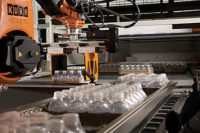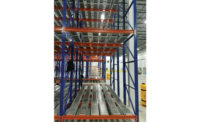As many have said during tough times, “There’s nowhere else to go but up.” In warehouses around the world, this phrase takes on a more literal meaning as the proliferation of SKUs forces many businesses to maximize the vertical space in their facilities with racking and automated storage and retrieval systems (AS/RS).
“[SKU proliferation is] causing a dramatic shift in the warehousing industry,” says Skip Eastman, president of Twinlode, South Bend, Ind. “Manufacturers and warehousing people are having a dramatically, continuously increasing number of stock-keeping units, and to maintain the density of flow with all of those different stock-keeping units has created a challenge in the entire industry.”
To accommodate this increased number of SKUs, the design of a warehouse might need to change slightly, suggests Dan Labell, president of Westfalia Technologies Inc., York, Pa. In the beverage industry, typically 80 percent of a company’s inventory is represented by 20 percent of its SKUs, he explains.
“You have to be able to manage the tail of these SKUs, as I like to call it, which is those last 300 SKUs of which you don’t sell much but you want to offer [them] as part of your deliverables because you want to provide the customer with more choices and things like that,” Labell says.
One strategy to address this challenge involves storing multiple slow-moving SKUs in the same lane and moving product out of the way if a SKU is needed behind it, he explains.
Turning to automation
SKU proliferation also has impacted the retail environment, which in turn has changed the format in which distributors deliver product to stores, says Lonnie Watkins, strategic account manager of integrated systems for Dematic North America, Grand Rapids, Mich. Instead of delivering full pallets of product for retailers to store and stock, outlets are demanding mixed pallets of SKUs and more frequent deliveries so that they don’t have to manage that inventory, he explains. AS/RS can help at the case level in this situation by acting as a storage buffer to connect these orders, he adds.
Another factor causing warehouses to implement racking and AS/RS is mergers and acquisitions (M&A) activity in the beverage space, Watkins says. According to Zenith International, Bath, U.K., food and drink M&A increased 9.4 percent from 2011 to 2012.
“We’re still seeing a lot of M&A activity in that space where multiple smaller companies are coming together to form bigger companies, and when that happens the volumes go up, and when the volumes go up the challenges of running a distribution operation go up with regard to labor and other things,” Watkins explains. “So, No. 1, you’ve got just a pure volume issue where it’s hard to find people [who] want to do that kind of work and do it well and do it accurately; No. 2, you’ve just got a sheer volume of things going on that make sense for automation, and it becomes a lot more realistic for these companies when their volumes grow like that to start thinking about the kinds of investments you have to make to install these types of systems.”
Once return-on-investment is considered, the facility should be evaluated to determine how much densification is possible, experts say. According to Bill Daniel, director of business development for ITW Warehouse Automation, Arden, N.C., an automated warehouse can be as much as 75 percent smaller than a conventional warehouse. By implementing an AS/RS, such as ITW Warehouse Automation’s cart-based system, companies can eliminate new capital costs from expanding or building a facility, reach higher capacity, and get higher throughput, enabling them to consolidate multiple distribution centers into one facility, Daniel explains.
In the AS/RS world, typical systems are crane-based, with a crane that goes up and down each aisle in a warehouse, Daniel says. In a cart-based system, a cart is placed on every level, leading to higher throughput and higher density, he adds.
Likewise, Dematic’s newest technology for cases, bins or tubs, the Dematic Multishuttle Captive storage system, places a vehicle on every level in every aisle, serviced by high-speed lifts. Designed for maximum flexibility, the Dematic Multishuttle Roaming storage system meets the need of low to medium throughput applications, the company says. Instead of dedicating one shuttle to each level, the vehicles can move between levels via shuttle lifts, it adds.
Compared with other industries in the United States, including food, retail and pharmaceutical, the beverage industry is lagging in terms of adopting automation, says Bill Leber, director of business development for Swisslog Logistics Inc., Newport News, Va. However, this does not remain true internationally. Therefore, Leber anticipates that eventually the beverage industry will embrace automation in the United States as well.
“Eventually, people, to improve their profitability, are going to focus on their operations and focus on minimizing the number of hand-offs in the distribution network, and that really fits into what automation can provide for you,” he says.
In the realm of storage systems, Swisslog offers its Vectura Stacker Crane, which supports single-, double-, triple- and multi-depth layouts up to 165 feet tall and can handle several pallets simultaneously, the company says.
Westfalia’s Labell notes that beverage companies have been focusing on automation on the manufacturing side of their businesses but not as much in the warehouse, which creates an opportunity for efficiency, accuracy and cost reduction.
Labell also points out that changes to beverage packaging, such as lightweighting plastic bottles, have affected warehouse storage. Because today’s beverage packages might not be as sturdy as they were in the past, many beverage operators have turned to racking, he says.
“They have to basically support each level inde-pendently with a rack system, and as soon as you do that, automation also then becomes more of a technology to look at, because once you have to buy racks anyway, why not look at automating that entire process?” he asks.
Twinlode makes structural and roll-formed racking systems for the beverage industry. One of its more popular systems for beverage warehouses is the Twinlode dual-pallet handling system, Eastman says.
“In the beverage industry, they generally handle two pallets at one time when they’re transporting them from manufacturing and storing them in their warehouse,” he explains. “They also ship them out the same way: When they load their trucks, they’re loading two pallets at a time, side by side.”
Twinlode’s dual-pallet handling system allows warehouses to store product multiple pallets deep and multiple levels high, two pallets at a time, Eastman says. As a result, product density is increased as much as 35 percent, productivity is increased as much as 50 percent, and efficiency and safety are improved, the company says.
Twinlode’s newest rack system is its Craft Barrel Rack. “In the beverage industry — primarily in the beer industry — they have a situation where they’re having a higher demand for craft barrels, or what they refer to also as one-sixth barrels,” Eastman says. “They needed something to be able to have a first-in, first-out, or a better way of managing their inventory and getting more density of storage in their warehouse.” Therefore, Twinlode launched the Craft Barrel Rack, which features a conveyor bed inside of the racking, enabling workers to load from the front or back, he explains. The rack can be configured up to four levels high to maximize storage capacity, the company adds.
With the number of SKUs consistently increasing and eating up space in beverage warehouses, operators are faced with two options: take up some type of automation or expand the facility, ITW Warehouse Automation’s Daniel says. Therefore, he expects automated systems to grow in the future. BI



